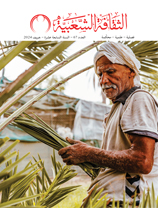Siwa Oasis: Folklore and cultural identity
Issue 17

Mustafa Jad (Egypt)
Wen studying Egyptian folklore in Siwa Oasis, we find this area is the site of many popular practices that relate to the place and its cultural identity. This study attempts to describe the relationships among elements of folklore in Siwa Oasis; these elements are reflected in popular celebrations, remedies, practices associated with the springs, and popular games.

Located around 300kms from the Mediterranean coast to the southwest of Marsa Matrouh, Siwa Oasis is considered part of Marsa Matrouh for administrative purposes. The oasis is 18 meters below sea level. In 2007, excavation revealed the oldest fossilized hominid footprint ever found; the footprint dated back three million years. Siwa’s main attractions are the ruins of Shali, the ruins of the oracle of Amon, (a deity in Egyptian mythology), the springs and ponds. The oasis is also renowned for its dates, olives, handicrafts, carpets, textiles, wicker, jewelry and fashion.
In addition to the oracle of Amon, the oasis has many ancient sites such as Al Maraqi and the tombs of the Mountain of the Dead; there are also sites such as Dakrour Mountain and the springs, where popular practices are still enacted.
Architecture is significant to the study of the oasis and its culture and arts, especially the architecture of Shali - the old town in the center of Siwa city – and, about 3kms from Shali, the village of Agurmi, which has ruins from ancient civilizations, narrow old streets and wells that are reminiscent of ancient myths and disappeared civilizations. People have started to build new housing around the ancient ruins.
Located about 5kms south of the oasis, Dakrour Mountain is known for its healthy climate and its abundant fresh water. This study attempts to identify the relationship between the practices of Siwa’s inhabitants and the mountain that is significant to many local customs, beliefs, stories and folkloric celebrations; this study does not necessarily address the ancient tombs of Dakrour Mountain, leaving it to archaeologists to study these tombs and their architecture.
The first popular practices associated with Dakrour Mountain are medical practices; until the 1930s, the people of Siwa used to camp on the sandy slopes of the mountain for a few days around the full moon in the month of Rajab. This was considered a vacation, and everyone ate as much garlic as possible in the belief that this would guarantee improved health for the rest of the year.
If Dakrour Mountain and its sands served a therapeutic function for the people of Siwa Oasis, the mountain’s geographic location and height also serve a function because tourists come to attend Sufi festivals, the spiritual dimensions of which also have therapeutic effects.
The springs of Siwa Oasis are a key element in regional popular practices; the most famous are the Hamam, the Tamousi, Al Qattarah and Qrisht. Some Arab authors have claimed that over one thousand springs flowed in Siwa. Springs play a role in the celebration of life in the Oasis. For example, the day before a circumcision, the baby's head is shaved, and then in the evening, relatives apply Henna to the child’s hands. The next morning, the baby is bathed in the Tamousi spring before he is returned to his home.
There is an obvious relationship between the springs and wedding rituals; at noon on the day of the wedding, the bride will bathe in one of the springs, while the groom bathes in another spring later that afternoon. The bride is escorted by female relatives and neighbors. In the past, they would travel to the spring on foot; nowadays, the bride travels by cart. The rituals are now observed more symbolically and the modern bride may opt to wash only her face and feet in the spring rather than being required to bathe in the spring.
At Tamousi spring, the bride takes the Idram (cylinder) from her Ighru (belt) and gives it to her mother or to an aunt for the future use of one of her young female relatives.
In the afternoon, the groom and two of his friends bathe in Al Qattarah spring. The groom wears an ordinary robe during his bath, which usually takes about an hour.




































































